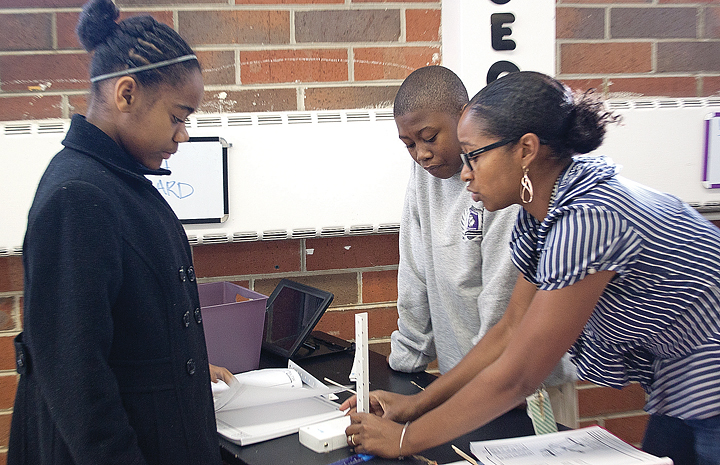Sixth graders Rebekah Williamson and Jerry Blanks sat across from each other at a lab table in a D.C. Virgo Middle School classroom Dec. 12, alternately examining an instruction manual and a contraption of paper girders and wooden dowels that stood between them. Blanks consulted his engineering journal in which he had sketched the final product, a miniature fairground ride. Their teacher, Shemeka Shufford, watched the contraption wobble slightly.
“Now, if this was actually made of metal and it had to load some heavy equipment, what do you think would happen?” she prompted.
“It would tip over,” Blanks responded, sticking the dowel through the girders to stabilize the model.
Connecting classroom learning to real-world scenarios is the purpose of Project Lead The Way, part of the science, technology, engineering and mathematics (STEM) curriculum at D.C. Virgo.
Shufford initiated the program at Virgo when she accepted her teaching position in 2013. Her first mission was to set up a STEM lab, a classroom environment where the students could work in teams to create hands-on engineering and robotics projects. She selected the school’s old woodshop and although her resources were limited, she was able to set up tables and order technology kits to construct basic machines.
Her plans for purchasing carpets, beanbag chairs and whiteboards for brainstorming sessions could become a reality soon due to a $6,000 donation from the charity element of the CastleBranch/PPD/McGladrey North Carolina Holiday Flotilla title sponsorship. She also hopes to purchase a three-dimensional printer for the program.
“How great is it, to design something on the computer but then be able to touch a tangible object you created,” she said.
Shufford said she introduced the children to basic engineering concepts through a series of fun, simple projects. Creating a rubber band car taught kinetic and potential energy. Firing marshmallows from an air cannon demonstrated projectile movement.
“To engage the students, first you have to make it fun,” she said, “and then they’re cruising and learning and they don’t even realize it.”
Her goal, she said, is not to turn the children into engineers, but rather to foster a curiosity for discovering how contraptions work. Still, she ties every aspect of the program to real-world scenarios.
“They have to label everything they do in their engineering notebooks,” she said, “because in the industry your engineering notebooks are like legal binding documents … and an important part of engineering is planning.”
After working with paper girders and beams, the children will take their skills to the computer to create digital projects and plans. The culminating project for the course is designing a virtual playground using design software.
Next year, the students will study automation and robotics. Shufford said the program has received funding to purchase robotics kits from which the children will create and program traffic lights, tollbooths and robotic arms. She has already introduced her students to some basic computer programming.
“They’re going online and creating their own games like Angry Birds,” she said. “They love it. … I turn them loose on their computers with their headphones and there’s not a sound in the room.”
Shufford is already planning new ways to expand the program and expose the students to more hands-on engineering opportunities. She wants to create an engineering club, she said, and take on community service projects like creating web pages for local churches.
“I want them to learn how to connect what they learn in here to what they do out in the community,” she said.
Shufford hopes Project Lead The Way will offer more than technical knowledge to her students.
“I think I’ve changed how they view engineering, that it’s not geeks running around with pencils behind their ears,” she said.
And in a school serving a large low-income population and with many students who struggle academically, she hopes to expose the children to new career possibilities — such as a job with General Electric, PPD or Corning Inc.
“The challenge is, the kids don’t know that this stuff even exists,” she said. “They’re not exposed to it. … But I try to teach them, you can’t always control your now, but sometimes you can control your tomorrow.”
email [email protected]




